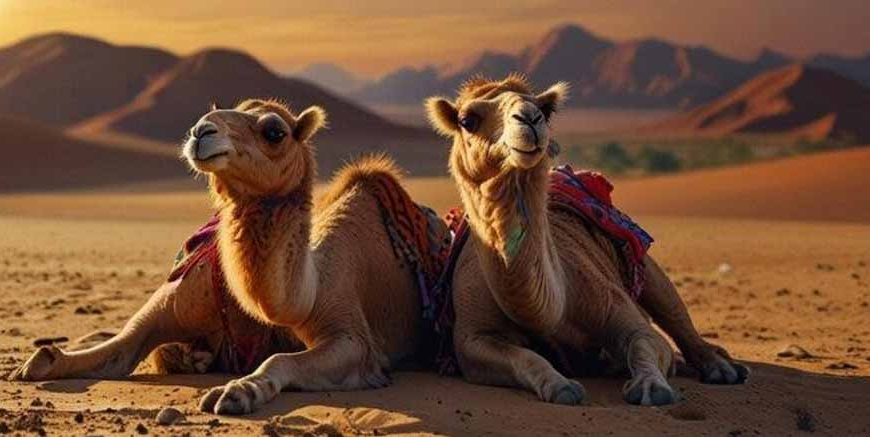Think you know everything about camels? Think again! While most of us grew up believing that camels store water in their humps to survive the desert life, the truth is far more fascinating. Those iconic humps actually contain fat reserves that fuel these incredible animals for weeks, even months. Fascinating, isn’t it? And that’s just the beginning. Camels are full of surprises that are sure to captivate young minds. In this article, we will explore some amazing facts about camels.
15 Interesting and Amazing Facts About Camels
Camels are truly fascinating animals, and there’s a lot more to them than just their humps! Here are some amazing facts about camels that are perfect for kids or anyone curious.
- Camels Are Born Without Humps
- Camels can drink up to 40 gallons of water in one go
- Camels have three eyelids
- Camels Can Live Up to 50 Years
- Camels are known as the “Ships of the Desert”
- Camels can run at speeds up to 40 miles per hour
- Camels provide more than just transportation
- Dromedary and Bactrian Camels
- Did you know there are different kinds of camels? Dromedary camels: These have one hump and are inhabitant of the Middle East and North African region.
- Bactrian camels: These have two humps and are found in Central Asia.
- A camel’s hump isn’t filled with water
- Camels have specially adapted feet
- Camels are built for the desert.
- One is the length of their eyelashes, to shut out sand.
- They can shut their noses to prevent sand from entering.
- Their big ears and dense body coat serve to protect them from the heat of the sun during the day and from cold during the night when they are in the deserts.
- Camels and Llamas Are Cousins
- Camels Are Social Animals and Like to Live in Groups
- Camels Spit to Defend Themselves
- Camels Can Survive in Other Climatic Conditions
Did you know that baby camels don’t have humps when they are born? After being pregnant for 12 to 14 months, a mother camel gives birth to one or sometimes two calves. Even though they are born without full humps, you can usually spot small, fluffy patches of hair on their backs that show where the humps will grow. And here’s another fun fact: some baby camels are born completely white. Their coats later turn brown as they grow older.
Can you imagine drinking 40 large jugs full of water in a few minutes? Well, camels can! They can drink up to 40 gallons of water in one go. This incredible drinking ability helps them prepare for long desert journeys where water sources are few and far between. Moreover, it also helps them go for several weeks without water. Share this interesting and amazing fact about camels with your little one and see what they have to think of this amazing superpower!
Camels live in deserts, where it’s easy for sand to get trapped in their eyes, and the third eyelid keeps dust and sand from getting into their eyes. Additionally, a camel’s third eyelid functions as a contact lens that allows them to see even in the middle of the sandstorms.
One of the most impressive facts about camels is that they can live as long as 50 years! This is partly because they don’t have many natural enemies in the wild. Another reason is their amazing ability to survive without food or water for days. Camels store fat in their humps and water in their bodies, which helps them survive in harsh desert environments where other animals might struggle.
An amazing fact about camels is that they are often called the “Ship of the Desert.” It has its origin from the logistics discharge duties of these vehicles as they move across expensive deserts. Several times larger than horses, camel can carry up to 990 pounds (450 kg) on its back. That’s like carrying five kids at once!
Camels are typically slow animals and will cover a distance of approximately 3 miles per hour when it comes to long-distance transport.
Camels have been used throughout human history for various purposes, not exclusively for riding. For instance, camel’s milk is a preferred dairy product in several parts of Africa, the Middle East, and Central Asia. Additionally, their milk is processed into cheese in some parts of the world. This makes camels a versatile animal with many benefits and uses—an interesting camel fact for preschoolers that you shouldn’t miss.
To your thinking, which type do you suppose is more frequently used? If you said ‘dromedary,’ you’re correct! Dromedaries constitute nearly 90% of all the camels found in the whole world.
A frequently believed fact about camels is that water is stored in their humps; however, they actually hold fat. The humps consist of fat deposits that the camel can use for energy in case of a lack of food. That bump can be as heavy as 80 pounds when crammed full!
Camel feet are like nature’s snowshoes. It is broad and long, which doesn’t allow the camel to sink in the sandy desert plains as we find in this region. For the same reasons, they bear large and tough leather-like pads on their feet to offer them protection against the hot sand.
A lot of features of the camel are designed to enable it live in hot, dry climates only:
Here’s a cool camel fact for kids: camels belong to a family of animals called Camelidae. Other members of this family include llamas, alpacas, vicuñas, and guanacos. Even though they are related, they live in very different parts of the world. Camels are usually found in the deserts of Asia and North Africa, while llamas and their cousins live in the mountains and grasslands of South America.
Camels don’t like to live alone. In the wild, they travel in groups called herds. A herd usually has one main male, several females, and their babies. Young males who leave their original herd sometimes form their own bachelor groups. Camels are also known to communicate with each other in fun ways. They make loud bellows and moaning sounds, and even blow air into each other’s faces as a friendly hello.
Camels are usually calm and gentle, but if they feel scared or threatened, they have a surprising way of protecting themselves—they spit! But it’s not just ordinary spit. What they actually throw up is a mix of saliva, bile, and partly digested food from their stomach. It’s more like vomit than spit!
This messy trick helps distract their attacker and gives the camel time to move away. And get this—the longest recorded camel spit reached up to 121 feet! That’s definitely one of the most amazing facts about camels and a fun one to remember.
Most of the time people associate camels with sandy deserts but the animals are also capable of living in other climatic conditions. Wild Bactrian camels are found in the rocky desert area of Mongolia and can tolerate extreme conditions; worse in winter it could reach -20°F to 100°F in summer.
Conclusion
Camels are incredible creatures that have many characteristics that don’t meet the eye. Their capability to store fat in their hump, drink gallons of water in a few minutes, spit as self-defence, and more are some interesting facts about camels that make them a favorite among kid. Want to discover more amazing facts about desert animals? Don’t miss our blog, List of Desert Animals and Their Adaptations, for more insights on desert animals. Don’t forget to check out EuroKids Blogs for more information on your little one’s learning and development. Also, check out EuroKids Preschools for the right first step in your child’s learning journey.
Related Blogs:
- Horse Facts for Kids: Check out this fun and educational read that helps you introduce your little ones to the world of horses, from their behaviour to how they communicate.
- Monkey Facts for Kids to Explore: Parents can spark their children’s curiosity by sharing fascinating insights about these playful primates.
- Jellyfish Facts for Kids to Discover: Check out this blog, which offers parents an exciting way to teach kids about ocean life. It features amazing details about these mysterious sea creatures.
- Space Rocket Facts For Kids – With this article, we hope to demystify space rockets and uncover some fascinating facts about them.















